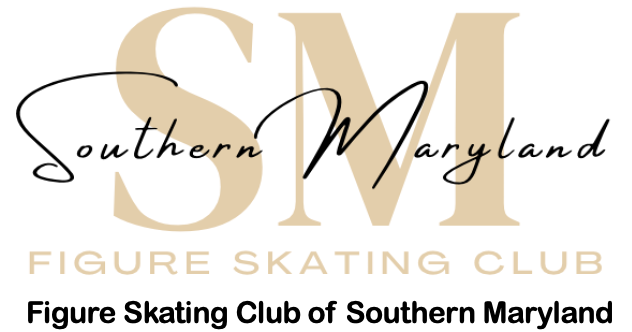The U.S. Figure Skating Test Structure
Welcome to Part 3 of the Figure Skating Club of Southern Maryland’s blog series, “Navigating the Ice!” We’re here to help skaters and parents explore and understand the world of ice skating, based on the official U.S. Figure Skating Journey, and identify your best skating path.
In this issue, we discuss the U.S. Figure Skating test structure, demystifying the ‘what,’ ‘why,’ and ‘how’ of testing in figure skating. Although we’ve briefly addressed testing in USFS in a previous blog post, this information is updated and more detailed. Join us as we shed light on this essential aspect of the skating experience.
Links are available below if you missed Part 1 or Part 2 of our new blog series.
Part 1: Learn to Skate, Introduction to Ice Skating Disciplines, and Membership
Part 2: Unveiling the Art of Singles, Pairs, Ice Dance, and Synchronized Skating
Part 3: The U.S. Figure Skating Test Structure
U.S. Figure Skating has developed a well-structured testing system that allows skaters to evaluate their skills and progress constructively. These tests are designed to be prerequisites for many competitions and serve as checkpoints that enable skaters to demonstrate their abilities and increase proficiency levels. By passing the final test in each pathway, skaters can achieve the prestigious U.S. Figure Skating Gold Medalist title, a great accomplishment and testament to their hard work and dedication.
What is testing in U.S. Figure Skating?
In U.S. Figure Skating, testing is a valuable opportunity for skaters to showcase their skills in different skating elements. This involves executing specific skills in front of qualified judges known as U.S. Figure Skating officials. These tests are not competitions but a chance for skaters to receive individual assessments and improve their proficiency in elements such as jumps, spins, footwork, and overall skating ability.
Why do skaters test?
Skaters decide to take tests for a few important reasons. First, testing helps skaters keep track of their progress. It’s like moving from one grade to the next in school – it shows how much a skater has learned and improved. Second, passing tests lets skaters move up to more challenging levels. This gives skaters something to work towards and motivates them to improve their skills. Lastly, testing allows skaters to get feedback from judges, which helps them know what they’re doing well and what they can do better.
Overall, the testing process is an excellent opportunity for skaters to evaluate their skills and progress constructively, and it plays a significant role in their continuous development as skaters.
Figure Skating Levels
Starting from July 1, 2023, U.S. Figure Skating has changed the names of some of its tests and test levels to reflect better the journey towards becoming a Gold Medalist. The tests are now categorized as:
Skating Skills (formerly known as Moves in the Field). Skating Skills consist of elements emphasizing basic skating skills, power, quickness, and edge control. The elements include patterns of turns, edges, spirals, and steps.
Singles (previously known as Free Skate). Singles are designed to display skill, grace, jumping ability, spins, and sequences. Before testing a specific free skate level, a skater must pass the corresponding moves in the field test.
Pairs involve performing jumps and spins in unison and partnered elements, including lifts, throw jumps, and death spirals. Good pairs skaters demonstrate symmetry and parallel flow across the ice.
Dance (including Pattern Dance and Free Dance) requires skaters to perform three to four set pattern dances per level.
See the updated USFS Testing Structure »
Additionally, a separate track is available for adults aged 21 and above. Stay tuned for upcoming blog posts where we will explore the different figure skating tracks in detail. Alternatively, you can check out the USFS Testing Structure Updates to learn more about the tests and levels.
As skaters pass tests at each level, they progress to the next one with more complex skills to learn. Therefore, each test passed is a significant milestone worthy of celebration. Once a skater successfully passes the final test in a given discipline, they are officially designated as a U.S. Figure Skating Gold Medalist. Therefore, a skater can earn the gold medalist designation in multiple disciplines.
How to Test
When figure skaters want to take a test, they must practice the skills required for that level. There are two ways to test:
Scheduled test sessions hosted by a figure skating club or
Submitting a competition protocol from a sanctioned U.S. Figure Skating competition. This option is available for free skate, pairs, and free dance tests at the juvenile-senior levels and select adult levels.
Traditionally, test sessions hosted by figure skating clubs were conducted in person. However, due to COVID-19, many clubs began offering virtual testing through USFS’ new Virtual Judging of Tests. During in-person tests, judges watch the skater perform and decide if they have completed the required skills for that level. If the skater passes, they can move up to the next level.
Virtual tests can run similarly to in-person tests, but the panel of officials is replaced with a videographer. Alternatively, the entire session can be virtual, with submissions uploaded through a system provided by the figure skating club and judged remotely. The club hosting the test will give specific guidelines for virtual tests to be successfully submitted. In the case of virtual tests, there is a delay in receiving testing results.
Adults can test in the adult testing structure. The qualifications and standards for all tests are specified in the current version of the U.S. Figure Skating Rulebook.
You can find test sessions by going to EntryEeze and selecting Find a Test Session. From there, you can enter your zip code to find the available test sessions closest to you.
In summary, testing in U.S. Figure Skating embodies a skater’s progression, dedication, and love for the sport. Testing is not just about passing levels but celebrating personal growth. Skaters showcase their abilities and foster a sense of accomplishment, setting and surpassing personal goals along the way. These tests provide milestones and invaluable feedback for improvement, fostering a supportive community. Embrace the journey, relish the progress, and let the passion for skating drive you forward!
Are you ready to embark on your figure skating journey? Whether you’re a novice lacing up your first pair of skates or an experienced skater looking to elevate your skills, our blog series is here to help you every step of the way. In the coming months, we’ll continue to provide advice, tips, and insights to guide you through this exciting world of figure skating. Let’s lace up, hit the ice, and unlock the magic of figure skating!

